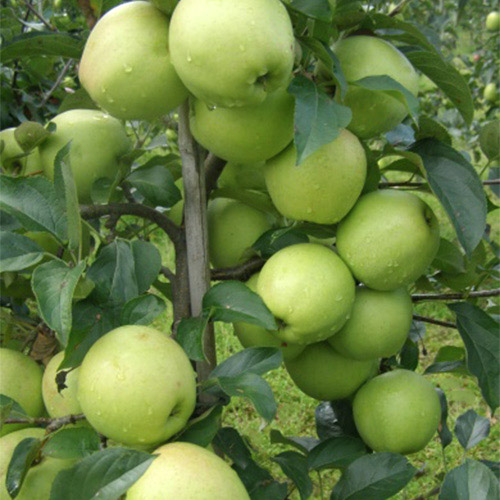
Golden Reinders Apple Tree
Origin: England
Description:The Golden Reinders apple tree is an English variety, renowned for its exceptional flavor and historical significance. It was once a highly popular commercial apple but has become less common in modern orchards.
Fruit: Golden Reinders apples are medium-sized with a distinctive appearance. The skin is greenish-yellow with a red flush and russeting, adding to its charm. The flesh is firm, crisp, and juicy, with a delightful balance of sweetness and tartness. The unique flavor profile has hints of honey and spice, making it a favorite among apple connoisseurs.
Harvest: The apples are typically ready for harvest in late September to early October. The yield can vary depending on growing conditions and pollination, but mature trees are known to be productive. It is important to harvest the fruits when they are fully ripe to experience their optimal flavor.
Pollination: Golden Reinders is a triploid variety, which means it requires two other apple varieties for effective pollination and fruit set. Suitable pollinators include Cox Orange Pippin, James Grieve, and Bramley Seedling. Planting these varieties nearby will significantly improve yields.
Spacing: This variety exhibits vigorous growth and can reach heights of 6-8 meters with a spreading habit. Standard spacing is around 6 meters between trees to accommodate its mature size and ensure good air circulation.
Good to know: Golden Reinders apples are versatile and suitable for fresh eating, cooking, and cider making. They store well, extending their availability throughout the fall and winter months. However, this variety is susceptible to scab and canker, so implementing a preventative spray program and maintaining good orchard hygiene is essential for disease management. Its historical significance and unique flavor make it a valuable addition to heritage orchards and gardens.
ask prices
- We only sell bare root trees to countries in Europe. We can't export potted trees due to trade regulations.
- We can deliver the trees to all countries in Europe and some countries in Eurasia and Middle East. We can arrange a truck to deliver the trees to your country.
- We are a wholesale nursery. Our minimum order quantity is 3.000 trees. Please note that we don't take orders below this limit.
- Phytosanitary certificates are provided with all orders. These certificates prove the origin of the trees and certify that they are free of diseases.
MM 9 (Dwarf)
M 9 is a dwarf rootstock suitable for high-density planting. It is resistant to the crown rot disease and moderately sensitive to the fire blight and wooly aphid. It is resistant to the illness of the tree tree and mildly susceptible to the blight of flames and wooly aphid. Throughout cultivation, it requires support systems. It should not be grafted on spur-type varieties such as Scarlett Spur, Redchief and Starkspur Golden. For the field, it should be recommended without limiting watering. It is moderately resistant to calcareous and heavy-textured soils. High crop quality, early fruit bearing and elevated efficiency out of a unit region within a brief span of moment are the most advantageous features M 9 offers to the plants.
MM 106 (Middle size)
It is a semi-dwarf rootstock, resistant to wooly aphid and is highly sensitive to disease of crown rot. For heavy-textured and argillaceous soils, it should certainly not be suggested. It has a closer and heavier root structure than rootstocks M9 and M26. Although it is more resistant to the climate than rootstocks M9 and MM 26, it should be chosen for frequent watering plants.For the gardens where MM 106 is grown, support devices are not needed. Within three or four years after planting, it becomes commercially profitable.
MM 111 (Large)
It is a semi-dwarf rootstock bigger than M106 and smaller than standard seedling rootstock. It is resistant to the illness of crown rot, wooly aphid and heavy-textured, argillaceous, calcareous plants with a pH scale above 7. Depending on the circumstances of care, it becomes commercially profitable within four or five years. When early flowering is desired, M 9 may be recommended as the rootstock between the system in some cases. When grafted on spur form and low strength varieties, it provides stronger outcomes.






